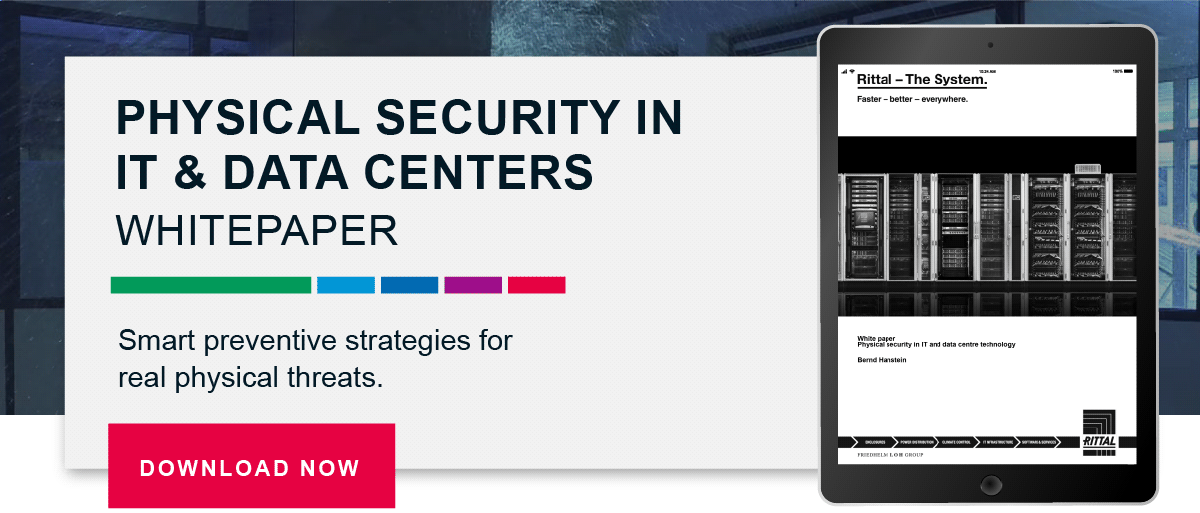IT Enclosure Security System Solutions
What keeps you up at night?
Fire and smoke. Corrosive gasses. Electromagnetic interference. Humidity. And let’s not forget - people.
When you take time to think about it, there are dozens of potential threats that could jeopardize your operations with IT failure or data loss. As hyper-discussed as cybersecurity is these days, anyone planning to develop an IT security system needs to first consider physical security, which instantly brings the conversation to server enclosures.
Not only does an IT enclosure, or cabinet, defend against unauthorized access, it protects sensitive IT components from many physical threats. Knowing that the integrity of your equipment and the safety of your data cannot be compromised, what are the most common threats to IT systems? And what critical measures need to be in place (as part of an enclosure) to protect against these threats?
You must also decide how much physical protection is required. Dust-proof and bomb-proof are two completely different levels of protection. There are multiple standards that not only identify the wide variety of threat agents but also threat levels for each type. How “big” is the dust you need to guard against? How much and how hard will water be present: a drip, trickle, stream, a leaky pipe, faucet, firehose? Protection should even include how “sophisticated” the person breaking into your cabinet is — A common thief? An experienced burglar with the proper tools?
You also have to decide how much protection is needed based on where you are. A Tier 3 or 4 data center should require less protection than an installation under a cell tower, in a field, in a desert, in August. Or on a cruise ship (suntan lotion and salt water spray, anyone?)
This article offers examples and provides answers, and one fact runs throughout everything covered: Achieving a maximum level of protection for any IT environment (an Edge system or other application) is only possible with the right IT enclosure.
Common Threats to IT Systems
Keeping your IT systems safe at all times is vital to your business; whether from cyber threats or physical (equipment failure, vandalism or break-ins, water leaks, heat and humidity). If you’re responsible for handling any and all physical threats to a data center, you’re likely always “on,” constantly wondering if there are ways to ensure more reliable, high-performance environments for business operations.
Of course, the two most critical physical threats (other than people) are DUST and WATER.
The IT enclosure industry uses IP (Ingress Protection or International Protection) standards to rate an enclosure’s ability to protect its contents. So, instead of relying on vague terms like “waterproof” to determine an enclosure’s capabilities, this standard’s 2-digit IP rating defines an enclosure’s resistance to ingress by the user, from particulates such as dust or dirt, and moisture ingress.
For example, here’s what an “IP68” rating means: The first digit, a number between 0-6, indicates the degree of protection from ingress of solid objects — 6 is the highest dust-resistance rating for a consumer device. The second digit, a number between 0-8, indicates resistance to moisture ingress — 8 is the highest water-resistance.
The type and amount of ingress within your environment determines what IP rating you need. An office environment, for example, may require a protection rating of IP20 for its IT equipment. However, an uncontrolled or “dirty” industrial environment, one that’s fully immersed in Industry 4.0 initiatives, likely needs to achieve an IP55 rating, protecting against dirt, dust, debris, water, solvents, etc. Because these could easily damage network equipment and hurt your investment in both equipment and data, you (and your enclosure partner) need to determine your IP rating based on the specific conditions and risks of that environment.
Oh, and one more threat to keep you up at night: the USB stick, thumb drive, jump drive, or whatever you want to call it. I call it a weapon, and one that can be easily inserted not into a server or storage device, but into a UPS, rackmount power strip or a host of “smart” devices. Devices with on-board intelligence and network communications capabilities (and a USB port).
Critical Measures to Protect IT Systems
IP rating is just one factor that contributes to the overall integrity of an enclosure. While standard IT racks offer a good level of protection, you may be in a situation where taking extra protective measures is necessary. This could be as simple (and effective) as a security safe (also called a Micro Data Center) with robust locking and security mechanisms. Think of it as a protective shell around the IT server enclosure.
Businesses with small IT environments and few racks appreciate a Micro Data Center’s affordability (and not having to convert an entire room into an IT-friendly space.) Medium-sized businesses with two or three server racks rely on Micro Data Centers and their abilities (depending on security class) to help with climate control, fire detection/extinguishing and power distribution. Some manufacturers of Micro Data Centers also offer other security enclosures (retrofits for existing IT racks, for example).
In addition to the common vulnerabilities (water, duct/particulates, heat, etc.), density shifts also need to be considered. The right solution is one that aligns with current thermal loads as well as those that need to be managed in the future. With network connectivity built into an enclosure, you can monitor and manage heat levels remotely.
Those environmental needs to be balanced by any security system’s flexibility. You need the ability to quickly scale to meet your evolving needs, and modular enclosures make additions and modifications simple and stress-free.
Fail-Safe Reliability = Peace of Mind
One way to think about IT enclosure security is this: the physical protection and security achieved at the IT rack level is the core of an entire security system. With constant availability being the goal, a comprehensive continuity plan that minimizes any potential system threats begins at the rack level in order to achieve a high level of fail-safe reliability.
The foundational IT security measures you follow may be heavily influenced by your industry’s regulations and having a minimum security level already in place. That can drive the right server enclosure for your environment. For instance, a doctor’s office guarantees confidentiality when sending electronic files so that protection level must be achieved, beginning with a secure server enclosure.
Enclosures have distinct differences that help reduce the risk of equipment failure, ultimately translating to less downtime, reduced costs, improved efficiencies and peace of mind. The only way to truly ensure that a server enclosure is right for a given environment is to consult with IT enclosure experts and base your decisions on the specific conditions and risks of your environment.




